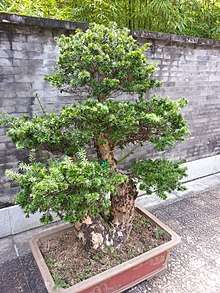Keteleeria fortunei
Keteleeria fortunei (zh: 油杉, you shan) is a coniferous evergreen tree native to Hong Kong and China in the provinces of Fujian, Guangdong, Guangxi, Guizhou, Hunan, Jiangxi, Yunnan, and Zhejiang. The tree grows in hills, mountains, and broadleaf forests at elevations of 200–1400 m. The species is named after Scottish botanist Robert Fortune, who discovered the tree in 1844.
| Keteleeria fortunei | |
|---|---|
 | |
| Scientific classification | |
| Kingdom: | Plantae |
| Clade: | Tracheophytes |
| Division: | Pinophyta |
| Class: | Pinopsida |
| Order: | Pinales |
| Family: | Pinaceae |
| Genus: | Keteleeria |
| Species: | K. fortunei |
| Binomial name | |
| Keteleeria fortunei (A. Murray) Carrière | |
It grows 25–30 m tall and 1 m in trunk diameter at breast height, forming a pyramidal crown with spreading, horizontal branches. The bark is dark gray, rough, and furrowed in a vertical pattern. Branchlets are orange-red and pubescent when young, turning yellow-gray or yellow-brown in their second or third year. The leaves are 1.2–3 cm long by 2–4 mm broad, stiff, sharply pointed on young trees and rounded or rarely slightly notched on mature trees. They are shiny dark green above and pale green on the underside with 12-17 stomatal lines on each side of the midrib. The cones are cylindrical, 6–18 cm long, 3–5 cm wide before opening and up to 7.5 cm wide after opening. They stand erect on short pubescent stalks and mature in October to a purple-brown color. The cones open upon maturity to release the seeds, which are large and oblong, 1-1.3 cm long with a yellow-brown wedge-shaped wing 3 cm long.
The tree is grown as an ornamental in warm climates, and the wood is used in construction and furniture, although the species is protected under Chinese forestry regulations.
K. fortunei has also been reported from Vietnam but this is attributed to misidentification of immature specimens of Pseudotsuga sinensis.[2]
Protection
In Hong Kong, this species is under protection based on Forestry Regulations Cap. 96A.
References
- Conifer Specialist Group (1998). "Keteleeria fortunei". IUCN Red List of Threatened Species. 1998. Retrieved 11 May 2006.CS1 maint: ref=harv (link)
- Luu, Nguyen Duc To; Philip Ian Thomas (2004). Conifers of Vietnam. ISBN 1 872291 64 3.
